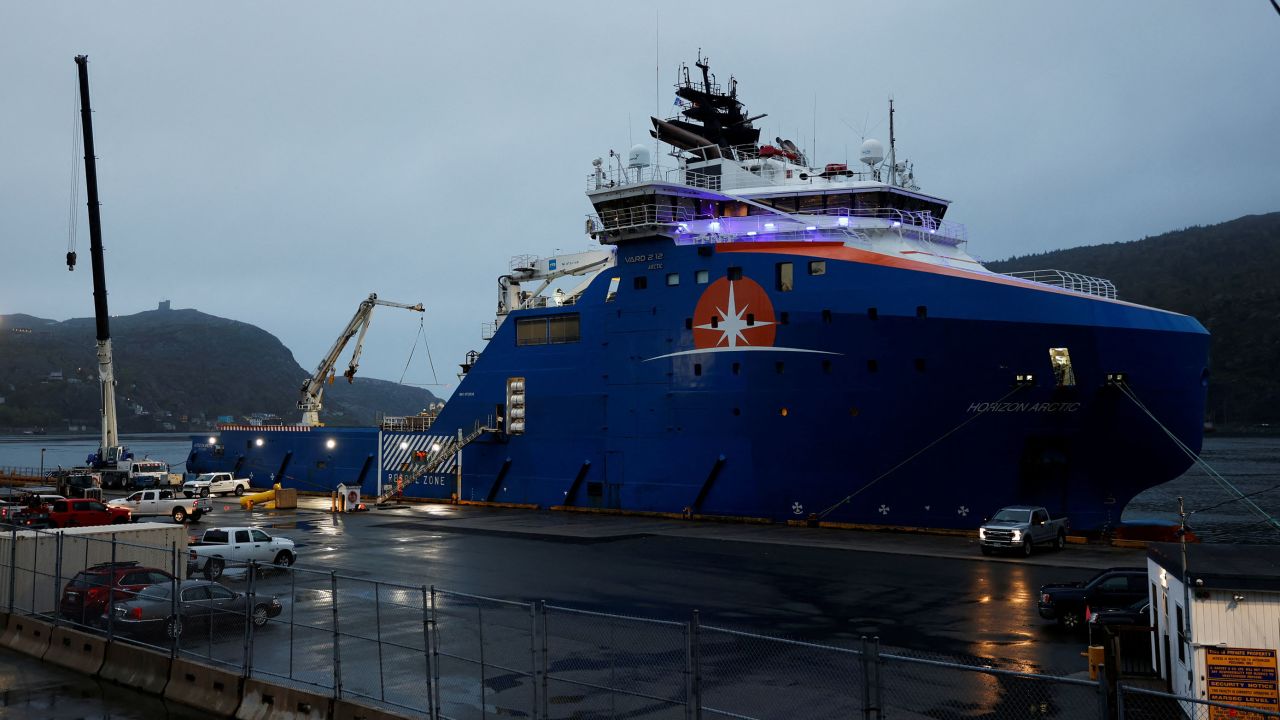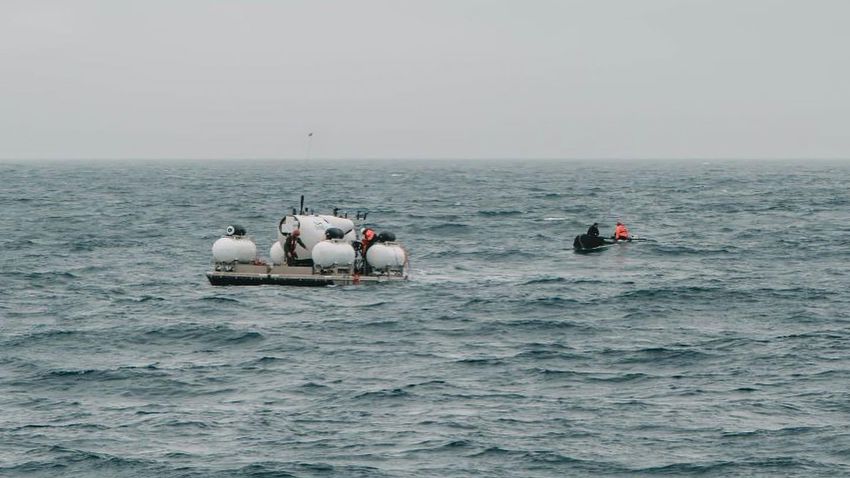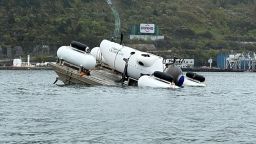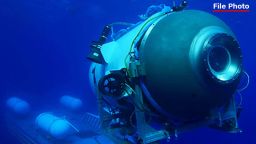Editor’s note: Find the latest story on the missing submersible here.
As experts examine underwater recordings of noises in the North Atlantic Ocean where a submersible with five people aboard went missing Sunday, the search for the vessel grew Wednesday. With oxygen supplies on board likely dwindling, time has become the biggest concern for rescuers.
The vessel was carrying a pilot, three wealthy adventurers and the submersible company’s CEO when it vanished Sunday morning about an hour and 45 minutes into its trek 12,500 feet deep, where the wreckage of the Titanic rests. The sub’s 96-hour emergency air supply could run out soon, setting up Thursday morning as an important search target.
It remains unclear whether the noises were heard Tuesday night and Wednesday morning were from the missing submersible, US Coast Guard Capt. Jamie Frederick said at a midday news conference. The banging on Tuesday first came every 30 minutes and was heard again four hours later, according to an internal government memo update on the search obtained by CNN.
Rolling Stone was first to report news of the banging.
“I can’t tell you what the noises are,” Frederick said, but he stressed that the operation was still a “search and rescue mission, 100%.”
If the craft is in the deep ocean, staying warm and lucid are the biggest struggles the five passengers of the Titan submersible may be facing now.
“They’re freezing cold. The water entirely surrounding the ship is at freezing or slightly below,” retired Navy Capt. David Marquet told CNN. “When they exhale, their breath condenses. There’s frost on the inside of the parts of the submarine. They’re all huddled together trying to conserve their body heat. They’re running low on oxygen and they’re exhaling carbon dioxide.”

Oceanographer and water search expert David Gallo told CNN his friend, passenger Paul-Henri Nargeolet, is a very experienced diver.
“He would understand the importance of conserving air as much as possible. He would try to get everyone to stay incredibly calm. I think working with that is the hypothermia… It is incredibly cold. So that might slow things down as well.
“In my case, I can’t think, I wouldn’t think about that. Except to know, like it is a race against yourself. We need to go full speed regardless of what that time is and find that submarine. And frankly, mathematically, it’s going to be almost impossible. We need a miracle. But miracles do happen,” Gallo said.
The Coast Guard on Wednesday night said more craft to help in the search are on their way, including three remotely operated vehicles and one ship with decompression chambers.
Sean Leet, the co-founder and chairman of Miawpukek Maritime Horizon Services, which owns the submersible’s mother ship, Polar Prince, told reporters Wednesday that searchers were “very aware of the time sensitivity around this mission” but said “we have to hold out hope.”
The expedition to see the Titanic’s wreckage – with prices starting at $250,000, according to an archived version of the company’s website – was part of the growing business of wealthy adventure tourism, along with the space flights of Blue Origin and the rise of guided tours to Mount Everest, and reflects the ongoing fascination with the Titanic more than a century after it sank on its maiden voyage, killing more than 1,500 people.
As the search for Titan continues, CNN has learned of at least two former OceanGate employees who expressed safety concerns about the vessel’s hull years ago, including the thickness of the material used and testing procedures. The 23,000-pound craft is made of highly engineered carbon fiber and titanium.
But the focus now is the massive search: The US is moving in military and commercial assets as aircraft from the Canadian Armed Forces, the US Coast Guard and the New York Air National Guard continue to look above and below water, and France’s president has dispatched a research ship with an underwater robot to join the search Wednesday.
“We just have to remain optimistic. We have to keep working until we find the submersible,” Joyce Murray, minister of Fisheries, Oceans and the Canadian Coast Guard, told reporters Wednesday. “We will continue to double down and to figure out where the submersible is and how it can be brought to the surface.”
What the banging might mean

The discovery of the banging offered hope but little clarity.
“We don’t know the source of that noise, but we’ve shared that information with Navy experts to classify it,” US Coast Guard First District Commander Rear Admiral John Mauger told “CBS Mornings” on Wednesday.
He described there being a lot of metal and other debris in the water around the Titanic site, adding, “That’s why it’s so important that we’ve engaged experts from the Navy that understand the science behind noise and can classify or give us better information about what the source of that noise may be.”
Carl Hartsfield, a retired Naval captain and director of the Woods Hole Oceanographic Systems Laboratory, told reporters Wednesday that experts are trying to discern the source of the banging noises.
“They have to put the whole picture together in context and they have to eliminate potential man made sources other than the Titan,” he said.
Three vessels arrived “on scene” Wednesday morning to join the effort, according to a tweet from the US Coast Guard’s First District.
One of the vessels – the John Cabot – has “side scanning sonar capabilities,” and joined the Skandi Vinland and the Atlantic Merlin on the search, USCG said.
Side scan sonar is a system used for “detecting and imaging objects on the seafloor,” according to the National Oceanic and Atmospheric Administration. However, side scan sonar cannot measure depth, so it is frequently used in coordination with other tools to create a more extensive survey of the ocean floor, NOAA said.
Frederick said early Wednesday afternoon the number of surface assets in the operation will rise from five to 10 in the next 24 to 48 hours, with two remotely operated vehicles underwater and more on the way. There are also ongoing aerial searches.
Aboard the Titan are OceanGate CEO and founder Stockton Rush, a source with knowledge of the mission plan said, along with British businessman Hamish Harding, Pakistani billionaire Shahzada Dawood and his son Sulaiman Dawood, and French diver Paul-Henri Nargeolet, according to relatives and social media posts. Officials have not publicly named those aboard.
Learning of the underwater banging “raised my hopes through the roof,” David Gallo, senior adviser for Strategic Initiatives, RMS Titanic, which owns the exclusive salvage rights to the 1912 wreck site. “PH Nargeolet, my very good dear friend, is the kind of person that if he were in that submarine that he would think this thoroughly through and would do something like that every 30 minutes.”
What we know about the timeline:
Friday, June 16:
If the sounds came from the submersible, it could be an indication the hull of the vessel is intact, Gallo said. But, he warned, “time is of the essence.”
The US Navy is sending subject matter experts and a “Flyaway Deep Ocean Salvage System” that can lift heavy undersea objects to assist in the search and rescue, a spokesperson said Tuesday. But it needs to be welded to a ship before it can leave port in St. John’s.
Still, the five people onboard face a dire situation, Gallo said. If the submersible is intact, the passengers would be dealing with dwindling oxygen levels and fighting cold, he told CNN.
Hypothermia would be an issue “if the sub is still at the bottom, because the deep ocean is just above freezing cold,” Gallo said. “It’s like a visit to another planet, it’s not what people think it is. It is a sunless forever, cold environment – high pressure.”
Chilly conditions and lack of light means those onboard will need to conserve energy, said Joe MacInnis, a physician and renowned diver who’s made two trips to the Titanic wreck.
“Resting, breathing as little as possible, and trying to keep calm – that is the most important thing,” he told CNN early Wednesday.
Frederick didn’t know Tuesday if there was enough time to save the five people onboard, but “we will do everything in our power to affect a rescue,” he said.
Already, more than 10,000 square miles have been searched, Mauger said Tuesday, across a zone that covers an area about 900 miles east of Cape Cod, Massachusetts.
Ex-employees expressed safety concerns

Court filings reveal OceanGate years ago was confronted with safety concerns about the vessel.
Two former OceanGate employees separately raised similar safety concerns about the thickness of the submersible’s hull when they were employed by the company.
David Lochridge, who worked as an independent contractor for OceanGate in 2015 and as its employee between 2016 and 2018, said he brought up concerns about the Titan’s hull, according to court documents.
Lochridge said no non-destructive testing had been performed on the Titan’s hull to check for “delaminations, porosity and voids of sufficient adhesion of the glue being used due to the thickness of the hull,” according to a countersuit filed after Lochridge was sued by OceanGate in 2018 for allegedly sharing confidential information.
When Lochridge raised the issue, he was told no equipment existed to perform such a test, the suit states. The lawsuit was settled and dismissed in November 2018; its terms were not disclosed, and Lochridge could not be reached for comment.
There was much additional testing after Lochridge’s time at OceanGate, and it’s unclear whether any of his concerns were addressed as the vessel was developed, court filings from the company indicate.
Another former employee of OceanGate who worked briefly for the company during the same period as Lochridge became concerned when the carbon fiber hull of the Titan arrived, he told CNN on the condition of anonymity because he is not authorized to speak publicly.
The hull had only been built to 5 inches thick, while he said company engineers told him they had expected it to be 7 inches thick, he told CNN, echoing Lochridge’s concerns about its thickness and adhesion.
When more concerns were raised by contractors and employees during his time at OceanGate, Rush, the CEO, got defensive and shied away from answering questions during all-staff meetings, the other former employee said.
When he raised directly to Rush concerns OceanGate could potentially be violating a US law relating to Coast Guard inspections, the CEO outright dismissed them, the former employee said, and that’s when he resigned.
CNN has reached out to OceanGate for comment on the former employee’s claims.

Safety concerns were also raised by The Manned Underwater Vehicles committee of the Marine Technology Society, which penned a letter to OceanGate in 2018 expressing concern over what it referred to as the company’s “experimental approach” with the Titan vessel and its planned expedition to the site of the Titanic wreckage, the New York Times reported Tuesday.
“Our apprehension is that the current experimental approach adopted by Oceangate could result in negative outcomes, (from minor to catastrophic) that would have serious consequences for everyone in the industry,” the letter, obtained by the Times, reads in part.
Specifically, the letter expressed concern over the company’s compliance with a maritime risk assessment certification known as DNV-GL.
“Your marketing material advertises that the TITAN design will meet or exceed the DNV-GL safety standards, yet it does not appear that Oceangate has the intention of following DNV- GL class rules,” the letter says. “Your representation is, at minimum, misleading to the public and breaches an industry- wide professional code of conduct we all endeavor to uphold.”

OceanGate has not responded to a request for comment on the letter.
Will Kohnen of the Marine Technology Society told CNN the vessel’s disappearance “may have been preventable if the vehicle had been certified.”
He said he and Rush “agreed to disagree” during their 2018 conversation over safety concerns.
The last communication between the vessel and its mother ship, the Polar Prince, came in at 11:47 a.m. Sunday. The sub was expected to resurface at 6:10 p.m. but did not do so, and authorities were notified at 6:35 p.m., according to Miawpukek Maritime Horizon Services.
The mother ship communicates with the vessel by text messages, and it’s required to communicate every 15 minutes, according to OceanGate Expeditions’ archived website.
Correction: An earlier version of this story gave the wrong name for the CBS morning show. It is "CBS Mornings."
CNN’s Eric Levenson, Oren Liebermann, Rob Frehse, Dave Alsup, Jacqueline Rose, Raja Razek, Laura Ly, Paula Newton, Artemis Moshtaghian, Celina Tebor, Gabe Cohen and Jose Lesh contributed to this report.




